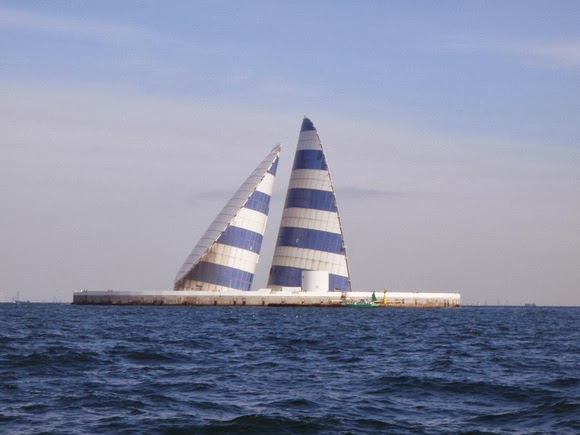Torres diferentes a otras torres.
 |
| link |
Gruuthuse museum is located in the Belgian city of Bruges and dates from the 15th century. It has a collection of applied art of Bruges from the 13th to the 19th century.
.jpg) |
| link |
Gruuthuse Tower is part of the museum and is better known as the Ivy Tower, because it is mostly covered with ivy vines. The tower looks especially nice in the autumn months, when the leaves of ivy takes on different colors (yellow, orange, red, brown…) [map]
2. Guinigi Tower, Italy
 |
| link |
The city of Lucca in Tuscany, Italy, is famous for its medieval architecture and intact city walls. Yet among all of its exquisite buildings one stands out. The Torre Guinigi or Guinigi Tower in English, towers over the city.
.jpg) |
| link |
At the top of the 44.5 meter (146ft) high tower is something of a surprise – a garden containing, of all things, oak trees. High above the city this small wood has provided a haven of peace for centuries.
 |
| link |
The tower was built in the fourteenth century when there were over 250 in the city. Although that number has, over the centuries, dramatically decreased, this one has survived. It was built by the Guinigi, then the most powerful and influential family in the city. The tower represented the prestige of the family and was the largest in the city even when the economic boom of the late fourteenth century meant that towers were springing up all over Lucca.
 |
| link |
The last descendant of the family gifted the tower to the city, as well as the palace at its base. The roof garden at the top of the tower is, effectively, a walled box filled with earth.
 |
| link |
There are seven oak trees there: it is believed that they were first planted in the 14th or 15th century but that over time they have been replanted. However, the ones atop the tower at the moment are still thought to be several hundred years old. [link, map]
.jpg) |
| link |
 |
| link |
 |
| link |
Yekaterinburg TV Tower is a tall incomplete structure in Yekaterinburg, Russia. Construction works started 1983, but were on-hold at the beginning of the 1990s, as its shaft reached a height of 220 metres (720ft). According to plans, the tower was intended to reach a structural height greater than 400 metres (1,310ft).
 |
| link |
There are three parts to the building: the trunk of the tower, the lower joint-work with the base and the metallic aerial. The tower has 26 floors in total (not accounting the floors which make up the base).
 |
| link |
The lifts were never installed. Instead any visitors must clamber up the concrete stairs of the half-complete tower. It is quite the local landmark.
 |
| link |
The tower has a slight lean due to engineering mistakes made in its construction. The list does not, however, present any danger and the tower is not due to topple over at any point in the near future. [link1, link2, map]
5. Ciechanow Tower, Poland
 |
| link |
The Ciechanow Water Tower in Poland is a hyperboloid structure, using hyperboloid geometry which maximizes structural strength with a minimum of material.
 |
| link |
The Ciechanow Water Tower was built in 1972 by Jerzy Michal Boguslawsk. There are plans to open a restaurant and observation platform at the top of the tower, but the object is currently out of use. [link]
6. The Pirate Tower, USA
 |
| link |
A Laguna Beach (California) landmark, this medieval-looking tower is located just north of Victoria Beach. Built in 1926, it was designed as a private spiraling staircase for beach access from above. Today the tower is closed but can still be viewed from the outside at low tide.
 |
| link |
To the uninitiated beach goer, the 60 foot (18m) rocket-like structure seems to have been carved out of the cliff by massive waves hundreds of years ago.
 |
| link |
Ocean breezes moan through small portals covered by rusting metal grates on the tower’s sides and a large door at the structure’s base, also covered in rust, reveals a wooden spiral staircase twisting to the ledge above. [link1, link2, map]
7. Sathorn Unique, Thailand
 |
| link |
The early 1990s was boom time for the Thai economy. The country was experiencing its most rapid development ever and hundreds of construction projects were started in the capital ofBangkok.
 |
| link |
As the wealth of the nation’s people increased it was envisioned that they would demand new, luxury apartments in which to live. The Sathorn Unique is one of them.
 |
| link |
The Sathorn Unique was supposed to be another glistening addition to Bangkok’s ever growing skyline, a luxury residential skyscraper of over 600 homes and shops. Yet the building work came to a drastic halt in 1998. The towering building has stood abandoned and incomplete from then on.
 |
| link |
Crows circle the pinnacle and rats call its lower levels home. Expat urban spelunkers have explored the building and returned to Khao San Road with stories from its upper reaches. The verdict: it is a dilapidated mess. The future of the Sathorn Unique remains unclear but perhaps someday it will be finished. For now, it looms on the Bangkok skyline with many other abandoned skeletal structures. [link1, link2]
8. Cheminée Moretti, France
 |
| link |
Cheminée Moretti is the work of French artist Raymond Moretti located in Courbevoie – a commune very close to the center of Paris.
 |
| link |
Cheminée Moretti is a system composed of 672 fiberglass pipe diameters ranging from 2 to 30 cm (1-12 inches). The pipes are painted in 19 different colors and have a total length of 22 kilometers (13.7mi), with a total weight of 27.5 tons.
9. Shime Tower, Japan
 |
| link |
The winding tower of the former Shime coal mine near the city of Fukuoka, Japan, is unusual even in a country chock full of abandonments. The Shime coal mine tower dates from the middle of World War II: it was built between 1941 and 1943 to help increase the yield of a coal mine established in 1889, and it’s really a wonder the Allies didn’t bomb it to smithereens. Operated by the Imperial Japanese Navy, the mine was rumored to have “employed” Allied POWs so perhaps its survival through VJ Day was just as well. Indeed, the tower and the mine below operated until 1964 when it was finally closed for good.
 |
| link |
The 47.65 meter (156.3 ft) tall tower is of an odd design, having offices and control rooms located above the actual, long gone winding mechanism – huge reels of cable which raised loads of coal from the mine and lowered empty containers and workers back into the depths of the mine up to 430 meters (1,411 ft) below. [link]
10. Montreal Tower, Canada
 |
| link |
The tower incorporated into the base of the The Olympic Stadium in the Montreal, called the Montreal Tower, is the tallest inclined tower in the world at 175 metres (574 ft). Its 45-degree angle is awe-inspiring, especially when you consider that the Leaning Tower of Pisa’s tilt is only 5 degrees.
 |
| link |
From its summit, visitors can admire the entire Greater Montreal region and up to 80 kilometres (50mi) of the St. Lawrence River valley. A breathtaking panorama, it has been awarded a three-star rating – the highest available – by the renowned Michelin Guide.
 |
| link |
A common question from visitors is how can a structure with an incline as dramatic as the Montreal Tower stand? The answer to this riddle lies in mass ratio: the top of the tower has a mass of 8,000 tonnes which is permanently attached to the infrastructure and the solid concrete base buried ten metres below ground level. This base has a mass of 145,000 tonnes, or the equivalent of three aircraft carriers.
 |
| link |
Visitors can reach the top of the Montreal Tower on a mesmerizing climb in a glass-encased funicular that holds up to 76 passengers. The funicular is the only one in the world that operates on a curved structure. It has a hydraulic system that allows the cabin to remain horizontal during the two-minute ride to the top. [link, map]
11. Tower of Wind, Japan
 |
| link |
Located just to the southeast of Tokyo’s Haneda airport, in the middle of the ocean, is a rather interesting structure. Referred to as the “Tower of Wind” of “Kaze no to” in local language, it consist of a dazzling white circular base with two blue and white stripped oval shaped structures, that look like two sails from the distance.
 |
| link |
This structure is actually a ventilation shaft for the Tokyo Bay Aqualine – an undersea tunnel that lies approximately 40 meters (130ft) below. Tokyo Bay Aqualine is the fourth-longest underwater, 9.6 kilometers (6mi) long that runs from Yokohama to Chiba under the Tokyo Bay.
.jpg) |
| link |
The tunnel took 31 years to build, cost 11.2 billion dollars, and shaves some 100km (62mi) off the round the Bay trip. The attractive monolith houses the tunnel’s intake and exhaust ventilation system and also marks the midway point of the undersea tunnel. [link, map]
12. PL Peace Tower, Japan
 |
| link |
Measuring around 600 feet (183m) high, this unusual tower is located at the Church of Perfect Liberty headquarters in Tondabayashi, Osaka, Japan. The tower stands as a monument to all the perished souls of war throughout all time. Within the tower is a shrine in which all known names of the lives claimed in human conflict have been recorded on microfilm and stored in a golden container.
 |
| link |
The structure was originally designed using clay by the church’s late second founder and was built in 1970. The newly developed technique of «shotcrete» was employed in the creation of the tower, formed by spraying concrete on to a wire netting.
 |
| link |
Once a year, the Church of Perfect Liberty headquarters is the site of one of the world’s largest fireworks shows. Every July 6th, the members celebrate the passing of their first founder with what they call the «PL Art of Fireworks.» Unlike most fireworks shows, which fire around 5,000 shells, the PL show consists of around 25,000 shells fired. During the finale about 7,000 shells are shot off in unison, lighting nearly the entire sky.
